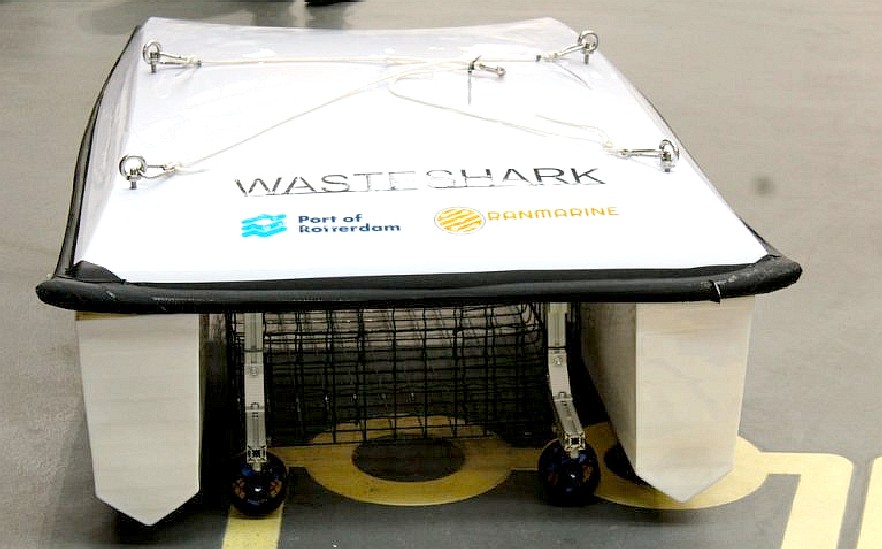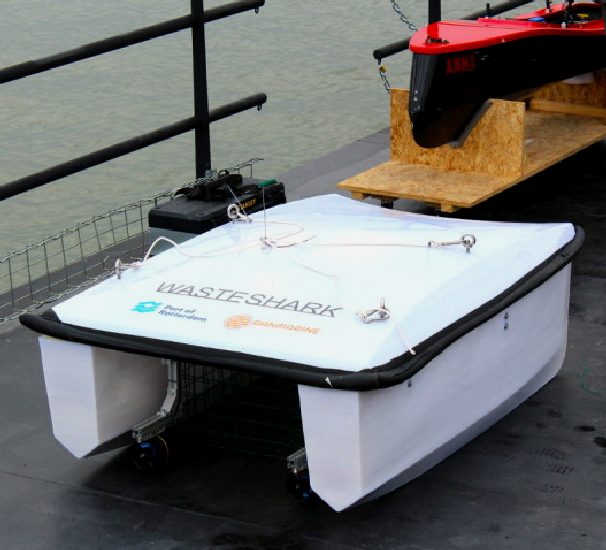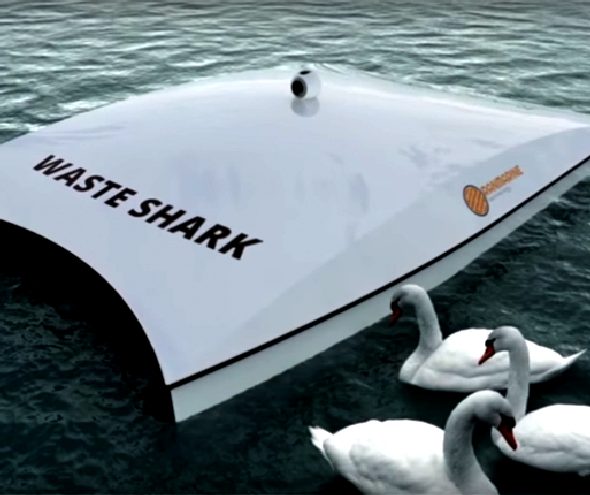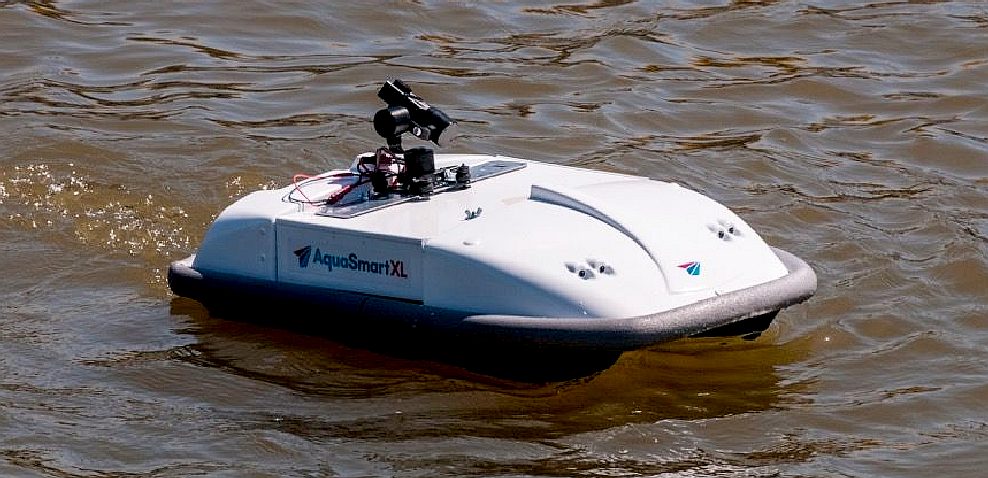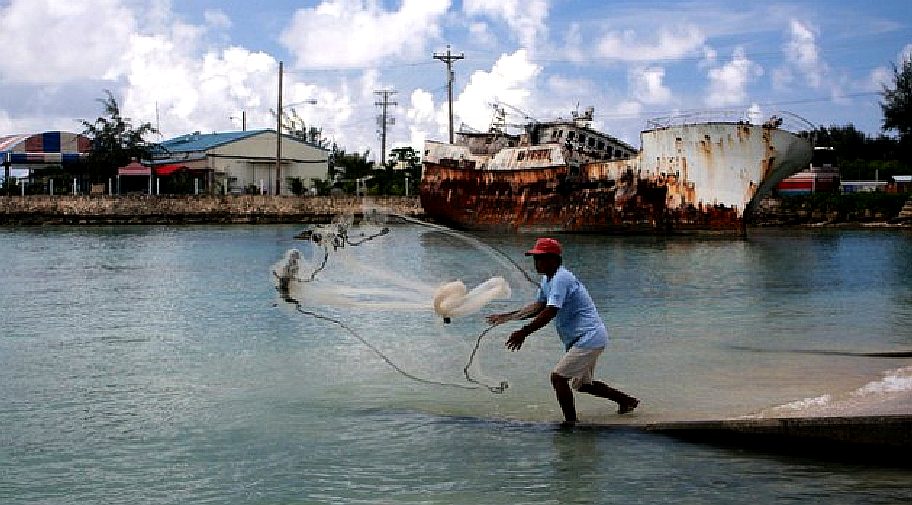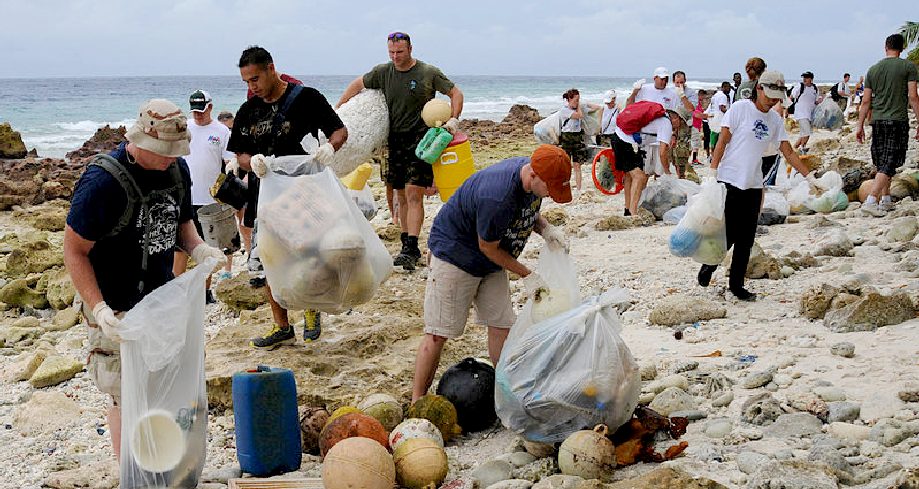|
RANMARINE'S - WASTE SHARK MEDIA REVIEW
CATAMARAN - A basic twin hull configuration with a metal wire basket to collect larger solids that are floating in the harbour of Rotterdam. The design is more Mantaray than Shark in our view, as this is a filter feeder, not a biting or shredding machine. We like the simplicity of the twin shrouded propellers that are used to steer the boat by varying the speed, much the same as employed on the AmphiMax™ virtual shipyard. Kort nozzles improve the efficiency of propellers by up to 15%. Contra-rotating propellers are even more efficient at converting rotary blade (or wing) movement in water into propulsive thrust, but the expense is so much more that only torpedoes and submarines use such technology routinely. Fixed stator blades are a stage in the middle, and also help to contain swirl that wastes energy.
SILICON ANGLE 9 SEPT 2016
CAN
DRONES CLEAN UP OUR PLANET?
All
rivers eventually make their way to the ocean, which means that any waste found in those rivers is ultimately deposited somewhere at sea. Due to water currents and wind patterns, much of this trash accumulates in certain parts of the ocean, such as the
Great Pacific Garbage
Patch, a massive stretch of waterborne waste that is estimated to cover an area of hundreds of thousands or even millions of square
miles.
By Eric David
HACKADAY SEPTEMBER 16 2016
POPULAR SCIENCE SEPT 12 2016
MEET WASTE SHARK THE DRONE THAT'S PICKING UP GARBAGE FROM THE OCEANS
ECO SNIPPETS
The Waste Shark is about the size of a passenger car and can vacuum up 1,100 pounds of floating trash. Because it can work 24/7, it’s incredibly efficient…
PORT OF ROTTERDAM - INSIGHT 7 JULY 2016
During Shakedown, PortXL’s grand finale, Hardiman signed a pilot contract with the Port of Rotterdam Authority. Over the next six months, four Waste Sharks will be ‘gobbling up’ the litter floating around in Rotterdam’s port basins. This system has been included in the Port of Rotterdam Authority’s Port Waste Catch project. The Port Authority will handle the further support of the pilot project.
PortXL
Open mouth
VOLUNTEER SAILORS - Beach cleaning parties like the one seen above are helping to slow the build up of plastic on our ocean floors. The only real solution is to stop using plastic, or to make recycling efforts really slick - something for our Governments to think on. Another way to help the situation is to deploy really large ocean going drones to capture the waste that inevitably escaped the net. Once such solution is called SeaVax™ and is one of the projects that the Cleaner Oceans Foundation are supporting. The Waste Shark is another great idea that if deployed effectively cannot but help to keep make our oceans cleaner. We say cleaner, rather than clean, because it is difficult at this time to be able to say at what level of contamination we might declare the oceans fit for marine life.
MENTAL FLOSS 15 SEPT 2016
RANMARINE'S FAQs
Q: Does the Shark Washes eat fish and other small animals.
A: No. Much like there are very few reports or fishbone "run over" by sailing boats, the fish gene rally swim away from the vessel. Birds also have the same reaction to the craft and react to it like most other vessels in the water ! a caveat to this: If we do start catching fish we just May pivot into the fishing industry.
Q: The vessel in the pictures looks too small to collect 500kg of trash.
A: You would be right, this is the smaller version with a lower payload that's present in testing at. our Great Waste Shark will be editable to collect a far higher payload with 500kg being our goal.
Q: What do you do with all the trash?
A: We work within the collection and hand over stretch of the circular economy; . as a business, we have to make a call as to where we stop and hand over to the next business to be everything to everyone quickly land you in hot water, if you will excuse the pun. So we work with partners in the recycling industries to take our trash and plastics, sort through it and recycle it, its the part of the economy that they do best, we are just a supplier.
Q: Why drones? Surely there are lots of These types of initiatives?
A : There are a number of initiatives That do an amazing job at cleaning up water all around the globe; However its not enough, if it was we would not have the pollution problem we have. we focus at what we call "at source"; our belief is that if you focus on where the majority of the plastic is coming from then we will start to strangle the feed That ends up in our oceans. Much like you vacuum continuously to clean your house of dust before it builds up, we want to efficiently and continuously "vacuum" or water, So THAT a build up of plastics never actually occurs.
Q: Why not concentrate on education rather than cleaning up?
A: Again, we have to chose where we pitch ourselves. we are a business ; if we were environmental crusaders alone, we would then need to rely on grants, donations and public funds-which does not give much of a life span to a project and it is hard to fight for.
We are business people and do see a value in what we are doing, not only financially but for shareholders also very much for our planet. if we can make a profit in order to keep cleaning up even more then we are happy.
We would be even happier if we were put out of business Because there was no more trash to collect. That would be the ultimate win.
We Hope that through what we do and our education and how we do it not only can we Promote the awareness that this issue so desperately needs but useful encouragement young innovators to come up with their own ideas and creative solutions.
Q: is is just a robotic vacuum cleaner for the water?
A: Yes as much as the shark swims Wash cleans and we make no bones about the simplicity our units. Of course there is a large amount of technology behind that simplicity but we are a company that believes in simplicity first.
How do you solve a problem without over engineering it; we use few moving parts and are creating a system that's automated to be more efficient.
Q: Will not it get in the way and sink other ships?
A: we are David to Goliath in the sense That we are taking on a huge problem, However When it Comes to a Wastewater vs. Shark an oil tanker the tanker wins every time. It's Important to remember we only operate where trash is gene rally known to collect in harbours, rivers and canals; this is based on known "waste chokeholds" based on tides, weather patters, wind and shipping movements .
All of this tells us predominantly where we can find the trash. We do not operate in major shipping lanes, in an uncoordinated and indiscriminate manner in high traffic areas and we make sure we are always efficient with how we deploy.
Added to this our drones are visible to shipping traffic in line with maritime laws, They are sentient and the last thing we want is a dead drone with waste everywhere ... we are rather fond and protective of them you see.
Q: What about the gyres plastic and islands?
A: There are amazing projects and ideas happening right now to start dealing with this massive problem, However again we have very deliberately chosen to act at source. axis long as we ignore where the trash comes from the gyres will be a continuous and ever growing problem.
We aim to start putting a dent in that problem by stopping it at source.
RANMARINE CONTACTS
There is no postal address, email or telephone number on the RanMarine website. There is a page where you can fill in your details and message the company. Click on the logo above to visit their official website.
IT'S NOT SPORTING - It could soon be dangerous to swim in a sea filled with toxic plastic waste. Ocean ally, Bluebird Marine Systems is pioneering eco robots that can vacuum up plastic waste and offload while at sea, by coupling with a converted bulk carrier called a PlastiMax.
LINKS & REFERENCE
http://www.rantech.nl/ http://www.popsci.com/popsci-authors/kelsey-d-atherton https://www.portofrotterdam.com/en/news-and-press-releases/waste-shark-this-shark-eats-plastic http://www.popsci.com/waste-shark-is-garbage-collecting-sea-drone http://www.ecosnippets.com/environmental/automated-drones-are-officially-cleaning-up-ocean-trash/ http://mentalfloss.com/uk/geography/46677/drones-are-now-cleaning-up-ocean-rubbish http://siliconangle.com/blog/author/ericdavid/ http://siliconangle.com/blog/2016/09/09/garbage-eating-drone-starts-cleaning-up-the-port-of-rotterdam/ http://hackaday.com/2016/09/16/waste-shark-aims-to-clean-our-harbours-and-oceans/ http://hackaday.com/2016/06/17/building-a-swarm-of-autonomous-ocean-boats/
|
|||
|
This webpage is copyright © Cleaner Oceans Club Ltd (Company No: 4674774) January 2017, Solar Studios, BN271RF, United Kingdom. The name Miss Ocean™ is a trademark of the Cleaner Oceans Club™.
|
